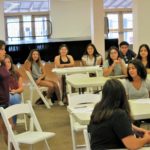I used to think of the 4-H Program as a place for kids to learn how to raise pigs or shear sheep—but no longer!
Renaissance Journalism is partnering with the 4-H Program of Imperial County to help young people in that desert community learn multimedia storytelling skills. Our goal is to empower young people with the ability to tell their own stories using 21st century media tools and techniques.
This is important to the region’s young people, who are saddled by negative stereotypes and low expectations. The Imperial Valley, which includes the county of Imperial, is a vast desert region along California’s border with Mexico. It is mostly known mainly for farming, which is the biggest industry by far, and the Salton Sea, which is dying. Poverty rates, environmental pollution and health problems run high.
Historically, a vigorous symbiosis exists between the U.S. and Mexican sides of the border. It’s not unusual for people to live on one side and to work and shop on the other side. Therefore, it’s not surprising that the majority of children in the county’s schools are of Latino descent.
A high school teacher once told me that many children can only imagine limited career choices—such as working for the farms, becoming a cop or landing a job with local government agencies.
To help young people reflect deeply about their lives and their futures, the Vesper Society, a San Francisco foundation, asked Renaissance Journalism to develop a program that would empower young people with media skills. The idea is that storytelling is a powerful way to help them examine their lives, uncover missing stories, and express their hopes and dreams for the future.
In the past, we’ve engaged talented school teachers, volunteer journalists and some of my colleagues at San Francisco State University to work with students. In this new phase, we have turned to the Imperial County 4-H Program. For generations, 4-H club members have raised farm animals as a way to gain leadership skills and learn the value of responsibility. But today, 4-H club members have branched out to explore a variety of new interests, including electronics and robot science.
Shanna Abatti, 4-H’s local program leader, immediately embraced the idea of creating a club focused on multimedia skills. Angel Esparza, the founder and design director of Mi Calexico, an online website, stepped up to serve as the volunteer leader. He developed a plan for a series of workshops that will teach writing, photography, video and graphic design.
The inaugural workshop was held on Saturday, July 8, at the Carmen Durazo Cultural Arts Center in Calexico. It attracted 15 girls and four boys, most of them of high school age. Many of the students said they were attracted because there were no other programs to feed their interests in photography, journalism and video. This is not surprising, as the Vesper Society has discovered that there only a limited number of extracurricular programs designed to enrich the experiences of children.
During a brainstorming session, the students developed a wide range of story ideas that they would like to pursue. One girl said she would like to be to explain what it’s like to grow up in a foster family because “no one ever talks about foster families.”
Another girl wanted to do a story about how difficult life was for her mother. She said that as a girl, her mother lived on the Mexican side of the border and had to cross the border every day to go to school. The routine continued into adulthood because her mother found work on the U.S. side of the border. “Basically, my mother spent her entire life in a car,” the girl said.
Esparza, who has helped to organize arts festivals in Calexico, stressed to the participants the importance of finding their “genuine” voice.
“No one has a story to tell but you,” he said. “Not everyone will like it, but if you are genuine, the genuineness will come out in your storytelling.”


